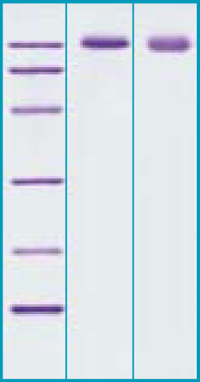Type
Native protein
Description
Native protein isolated from human urine, 590 AA, 64,265 kDa (calculated without glycosylation). Protein identity confirmed by MS.
Amino Acid Sequence
DTSEARWCSECHSNATCTEDEAVTTCTCQEGFTGDGLTCVDLDECAIPGAHNCSANSSCVNTPGSFSCVCPEGFRLSPGLGCTDVDECAEPGLSHCHALATCVNVVGSYLCVCPAGYRGDGWHCECSPGSCGPGLDCVPEGDALVCADPCQAHRTLDEYWRSTEYGEGYACDTDLRGWYRFVGQGGARMAETCVPVLRCNTAAPMWLNGTHPSSDEGIVSRKACAHWSGHCCLWDASVQVKACAGGYYVYNLTAPPECHLAYCTDPSSVEGTCEECSIDEDCKSNNGRWHCQCKQDFNITDISLLEHRLECGANDMKVSLGKCQLKSLGFDKVFMYLSDSRCSGFNDRDNRDWVSVVTPARDGPCGTVLTRNETHATYSNTLYLADEIIIRDLNIKINFACSYPLDMKVSLKTALQPMVSALNIRVGGTGMFTVRMALFQTPSYTQPYQGSSVTLSTEAFLYVGTMLDGGDLSRFALLMTNCYATPSSNATDPLKYFIIQDRCPHTRDSTIQVVENGESSQGRFSVQMFRFAGNYDLVYLHCEVYLCDTMNEKCKPTCSGTRFRSGSVIDQSRVLNLGPITRKGVQATVS
Source
Human urine
Purity
˃ 90 % by SDS-PAGE
SDS-PAGE Gel
12% SDS-PAGE separation of Human Uromodulin
1. M.W. marker – 14, 21, 31, 45, 66, 97 kDa
2. reduced and heated sample, 2.5μg / lane
3. non-reduced and non-heated sample, 2.5μg / lane
Endotoxin
< 1.0 EU/µg
Formulation
Filtered (0.4 μm) and lyophilized from 0.5 mg/mL solution in water for injection.
Reconstitution
Add water for injection to prepare a working stock solution of approximately 0.5 mg/mL and let the lyophilized pellet dissolve completely.
Applications
Western blotting, ELISA
Shipping
At ambient temperature. Upon receipt, store the product at the temperature recommended below.
Storage/Expiration
Store the lyophilized protein at -80 °C. Lyophilized protein remains stable until the expiry date when stored at -80 °C. Aliquot reconstituted protein to avoid repeated freezing/thawing cycles and store at -80 °C for long term storage. Reconstituted protein can be stored at 4 °C for a week.
Quality Control Test
BCA to determine quantity of the protein.
SDS PAGE to determine purity of the protein.
Endotoxin level determination.
Note
All donors of urine samples used for protein preparation were tested and found negative for HBsAg, anti-HCV, HIV Ag/Ab, and syphilis. Since no test can absolutely assure the absence of all infectious agents, this product should be handled as a potential biohazard. This product is intended for research use only.

